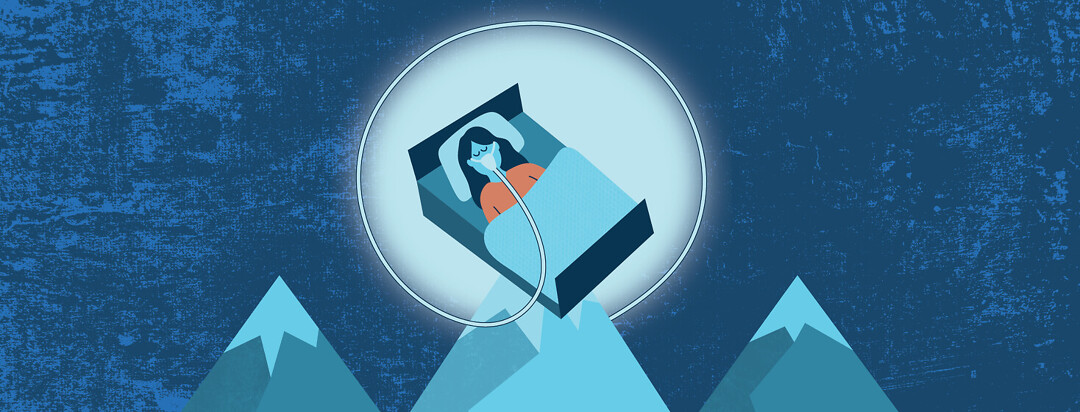Sleep Apnea in the Mountains
The high point of summer 2021 – both literally and figuratively – was a 2-week trip to Colorado in July.
Figuratively, because summer in the Rocky Mountains is tough to beat for natural beauty and recreation. Literally, because my husband and I spent almost every day at an elevation topping 8,000 feet above sea level (coming from Dallas at just 500 feet, by way of comparison).
Adjusting to the elevation
Flatlanders like us typically find adjusting to high elevation a bit bumpy for a few days due to the lower level of oxygen in the air. Categorically, this is referred to as altitude sickness. Individuals experience it in different ways.
The mildest form is called acute mountain sickness (AMS), with common symptoms including headache, tiredness, vomiting, confusion, dizziness – and trouble sleeping. (See where this might be heading?) About 20 percent of people feel the effects of AMS after rapidly going up to 8,000 feet; 40 percent do at 10,000 feet.1
Elevation and sleep
High elevation can disrupt your slumber because the low oxygen can directly affect the sleep center of the brain. Frequent awakenings, light sleep, and less total time of sleep are the main problems, though they usually improve after a few nights as your body adjusts to its new reality.
For people with sleep apnea, higher altitude can make breathing more difficult. But other than being out of breath any time I exerted myself on the bike or a hike (the price you pay for adventure), I felt fine when we arrived at a friend’s house in Creede (8,799 ft.).
I dare say I even got a better night’s sleep than most of the household – snoozing a solid 8+ hours every evening. Could it have been because of my CPAP machine? Maybe.
CPAP therapy and high elevation
There’s been limited research into whether CPAP treatment helps people with obstructive sleep apnea (OSA) living at high elevation.
A 2011 study found that people with moderate-to-severe OSA living at higher elevation were more likely to develop central sleep apnea as well. But if they used a properly calibrated PAP machine, those who had developed central sleep apnea at higher altitudes did show clear improvements.2
CPAP and high-altitude pulmonary edema
CPAP therapy is also a tested temporary treatment for people who suffer from a very severe form of altitude sickness, high-altitude pulmonary edema (HAPE). With HAPE, fluid collects in the lungs of even healthy people when they rapidly go up in elevation. CPAP is used temporarily until sufferers can descend to lower elevation and receive supplemental oxygen.3
Would my CPAP work in the Rockies?
This is all knowledge gained after the fact, however. Although we travel to Colorado at least once a year, it honestly never occurred to me to investigate whether my CPAP would even work up in the Rockies!
Because I started out sleeping just fine, it wouldn’t have occurred to me this time either. Then we got to Leadville.
Two-mile-high city blues
Leadville, CO, is the highest incorporated city in the U.S. at 10,152 feet – that’s almost 2 miles above sea level. I could feel it in every turn of my bike pedal, every step up a flight of stairs. And, for the first time, I felt it lying down as well.
At times, my heart pounded as I struggled to catch my breath. Putting on my full-face mask, the pressure of the air streaming from my CPAP felt smothering, causing me moments of panic until I removed the mask for a breather.
Something was off with my AHI readings
I woke up several times the first night, easily roused. I knew something was off when I looked at my sleep report the next morning. My AHI reading was 0.9! An average of less than 1 apnea per hour (a fraction of my normal reading)? Ha ha ha. If that were true, I should have been feeling awesome. Instead, I was drowsy. At the time, I couldn’t figure it out. In hindsight, I have a clue.
Pressure levels and PAP machine limits
People talk about the air at high elevation being “thinner” because there are fewer oxygen molecules. Few oxygen molecules also mean a drop in the air pressure. So, the pressure exerted by the machine is lower than your prescribed pressure, even when it’s set at the pressure level your healthcare provider prescribed.
Fortunately, modern CPAP systems include a function called “auto-altitude adjustment,” where the machine automatically detects changes in elevation and adjusts the therapy pressure accordingly. But there’s a limit. For example, my ResMed Autosense 10 does adjust automatically to elevation. But the user manual also clearly states that it’s guaranteed valid only to 8,000 feet.
That’s usually plenty – but not in a perch like Leadville. So, my machine was struggling, and so was I, at least for a few days.
Talk to your healthcare provider
Now I know that super-high elevation can affect both me AND my CPAP machine. So, if I plan to spend any nights well above 8,000 feet on my next vacation, I’m planning to talk to my doctor beforehand.
There are other treatments, such as a short course of the diuretic drug acetazolamide, that have been shown to help where a CPAP falls a little short.4. Because this flatlander isn’t giving up her love for the mountains over a little less oxygen!

Join the conversation